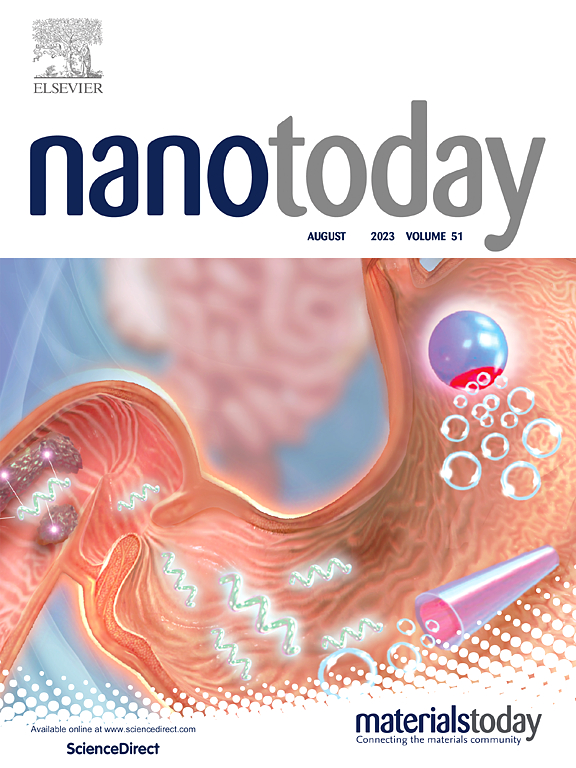Natural-based UV-shielding additives to protect photosensitive pesticides: Production of nanoparticles from the co-self-assembly of lignin and tannin
IF 13.2
1区 材料科学
Q1 CHEMISTRY, MULTIDISCIPLINARY
引用次数: 0
Abstract
This work explores the development of a renewable, carbon-neutral, light-colored UV-shielding film to protect photosensitive pesticides from solar radiation, as these chemicals are easily degraded under UV light, substantially reducing their efficiency and causing soil and water pollution. The abundant benzene rings in lignin and phenolic hydroxyls in tannin boosted the co-self-assembly of lignin and tannin into composite nanospheres by the simultaneous π-π stacking and H-bonding interactions between these two biopolymers. These lignin-tannin (LT) composite nanoparticles were used as natural UV-shielding additives to coat a poly-vinyl-alcohol (PVA) film, endowing the PVA-LT film with an excellent UV-shielding ability (>95 % efficiency) due to the strong π-π stacking and concentrated phenolic hydroxyls. Typical photosensitive pesticides covered with the PVA-LT film significantly increased their remaining rate by 1.5 times compared to those under the uncoated film. Besides, intensive intermolecular hydrogen bonds were generated between PVA and the abundant phenolic hydroxyl groups exposed on the hydrophilic shell of the LT coating, enhancing the mechanical properties and water vapor retention of the composite film. Our biodegradable composite film derived from natural plant extracts not only protected photosensitive pesticides from UV irradiation but also allowed the transmission of visible light to guarantee the photosynthesis process of crops.
保护光敏农药的天然紫外线屏蔽添加剂:利用木质素和单宁的共自组装生产纳米颗粒
由于光敏性农药在紫外线照射下很容易降解,大大降低了农药的使用效率,并造成土壤和水污染,因此这项研究探索开发一种可再生、碳中性、浅色的紫外线屏蔽膜,以保护光敏性农药免受太阳辐射。木质素中丰富的苯环和单宁中的酚羟基通过这两种生物聚合物之间同时存在的π-π堆积和H键相互作用,促进了木质素和单宁共同自组装成复合纳米球。这些木质素-单宁(LT)复合纳米粒子被用作天然紫外线屏蔽添加剂,涂覆在聚乙烯醇(PVA)薄膜上,由于强π-π堆积和浓缩的酚羟基,PVA-LT 薄膜具有极佳的紫外线屏蔽能力(效率高达 95%)。与未涂覆薄膜相比,涂覆 PVA-LT 薄膜的典型光敏农药的残留率显著提高了 1.5 倍。此外,PVA 与暴露在 LT 涂层亲水外壳上的大量酚羟基之间产生了密集的分子间氢键,从而增强了复合薄膜的机械性能和保水性。我们从天然植物提取物中提取的可生物降解复合膜不仅能保护光敏农药免受紫外线照射,还能透过可见光,保证农作物的光合作用过程。
本文章由计算机程序翻译,如有差异,请以英文原文为准。
求助全文
约1分钟内获得全文
求助全文
来源期刊

Nano Today
工程技术-材料科学:综合
CiteScore
21.50
自引率
3.40%
发文量
305
审稿时长
40 days
期刊介绍:
Nano Today is a journal dedicated to publishing influential and innovative work in the field of nanoscience and technology. It covers a wide range of subject areas including biomaterials, materials chemistry, materials science, chemistry, bioengineering, biochemistry, genetics and molecular biology, engineering, and nanotechnology. The journal considers articles that inform readers about the latest research, breakthroughs, and topical issues in these fields. It provides comprehensive coverage through a mixture of peer-reviewed articles, research news, and information on key developments. Nano Today is abstracted and indexed in Science Citation Index, Ei Compendex, Embase, Scopus, and INSPEC.
 求助内容:
求助内容: 应助结果提醒方式:
应助结果提醒方式:


